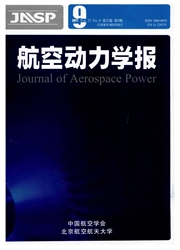

 中文摘要:
中文摘要:
为提高燃气涡轮发动机性能,设计了涡轮叶间燃烧室模型,利用FLUENT软件的Realizable k-ε湍流模型、概率密度函数(PDF)燃烧模型、离散坐标(DO)辐射模型和离散相模型对燃烧室的流动及燃烧进行数值模拟.结果表明:燃烧室燃烧效率高达98.4%,绝对压力损失低至4.2%,气体温度提高700K左右;出口径向温度随无量纲高度呈线性分布;速度、温度、组分分布受高温燃气与主流的掺混程度控制;径向槽(RVC)对促进掺混及改善出口温度场有着积极的影响,其结构值得深入研究.与文献实验数据对比发现:选择的数学模型合理,计算方法可行,其结果可为涡轮叶间燃烧室设计提供参考.
 英文摘要:
英文摘要:
To improve the performance of gas turbine engines, a turbine inter-vane burner (TIB) was designed. The Realizable k-ε turbulent model, probability density func- tion (PDF) combustion model, discreate ordinates (DO) radiation model and discreate phase model (DPM) of FLUENT were used to simulate the turbulent flow and combustion in the burner. It' s observed that the TIB can increase the gas temperature by about 700 K with 98.4G combustion efficiency and 4. 20//oo absolute pressure loss. The radial temperature grows linearly with the dimensionless height. The distribution of the velocity, temperature and species are controlled by the degree of mixing of the combustion products and the main flow. Given the radial vane cavity (RVC) plays an important part in improving the outlet temperature profile, its shape deserves more study. Compared to the literature experimental data, it indicates that the mathematical models and numerical methods are reasonable and the numerical results provide an important reference to the design of TIB.
 同期刊论文项目
同期刊论文项目
 同项目期刊论文
同项目期刊论文
 A Comparative Study between Combustion Performances of Turbine Inter-guide-vane Burner and Trapped V
A Comparative Study between Combustion Performances of Turbine Inter-guide-vane Burner and Trapped V 期刊信息
期刊信息
